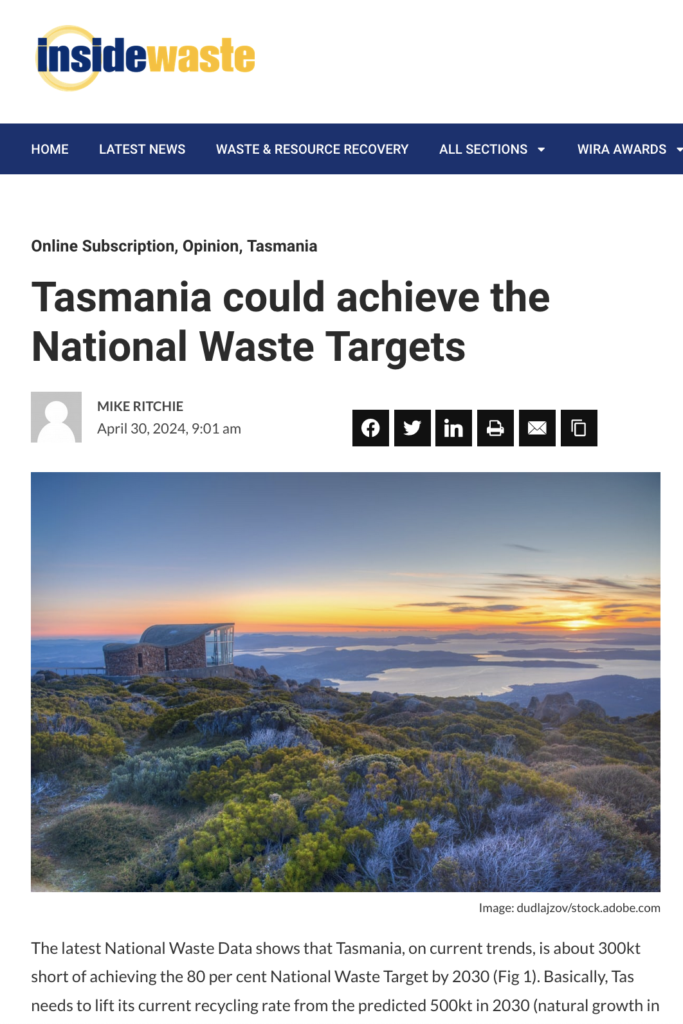Tasmania could achieve the National Waste Targets with concerted action

By Mike Ritchie, Director, MRA Consulting Group
The latest National Waste Data shows that Tasmania, on current trends, is about 300kt short of achieving the 80% National Waste Target by 2030 (Figure 1).
Basically, Tas needs to lift its current recycling rate from the predicted 500kt in 2030 (natural growth in recycling) to 850 kt in 2030.
300kt is not a huge uplift in the context of the opportunities for recycling in Tasmania. If it could achieve it, Tasmania would be one of only two States that might possibly hit the 2030 Targets. South Australia is the only other State with any chance at all of achieving the National targets of:
- 80% resource recovery by 2030;
- 50% reduction in organics to landfill by 2030;
- 10% reduction in per capita waste generation by 2030.

Achieving the targets also means reducing landfilling from the current 400kt to about 200kt. Capturing half of the material currently going to landfill and recycling it, is not difficult given the low (in absolute tonnes) starting position of Tasmania.
In particular, Figure 2 shows that Tasmania still landfills most of its Construction and Demolition waste.
While the State is rapidly growing and generating more construction waste, the very low landfill costs in Tas make it easier to landfill construction materials than try to recycle them. Figure 2 shows the recycling rate for C&D waste is near zero.
With a current landfill levy of only $20/t, landfilling remains cheap in Tasmania. The only cheaper landfills are remote landfills in WA and the NT. Levies in other States are sitting at between $120 and $160/t on top of the costs of operations.
To create a more circular economy, fixing the costs of landfilling would be the simplest and most effective policy choice for the Tasmanian government.

Of course, if the Government was anxious about how local government might react, it could adopt a QLD style model of compensating local government for the levy increase and slowly reducing that compensation over time.
Figure 3 shows a confusing picture for Council and household waste. The data supplied to the National Database by the Tas Government seems to indicate that waste generation is decreasing over time. That can only be dodgy data. In a growing economy with growing population, it is highly unlikely that waste generation rates are falling.

As I have stated in the past in relation to data:
- Voluntary surveys of Councils generate notoriously bad data,
- Volume based conversions from “ute load” etc are highly variable,
- Weights via scales are the only reliable metric,
- All landfills above say 1000t/yr should be required to have weighbridges.
Leaving aside the data issues in Tas, it is likely that the key metrics to improve resource recovery in the domestic sector are the same as for all other States:
- Food and Garden organics collections (FOGO);
- Container Deposit Schemes to capture containers from the red (landfill) bin;
- Product Stewardship (PS) schemes to capture specific streams such as furniture and textiles; and
- Higher landfill costs to drive source separation economics and recovery from the Bulky Waste Stream and household delivered wastes.
Figure 4 shows that the Commercial and Industrial sector is following a similar growth pattern to other States in Australia. Population growth and almost 30 years of recession proof economic growth are driving higher waste generation.
Recycling rates are growing with generation but at a lower rate. Waste to landfill is still growing.
The main reforms are well known:
- Higher landfill charges to drive source separation and recycling (usually via a higher levy);
- Grants to bring forward investment in resource recovery infrastructure;
- PS schemes for specific waste streams such as solar, e-waste, tyres and furniture to name a few;
- Commercial food recovery and reuse.

Summary:
- Tasmania could achieve the National Waste Targets but it needs to act quickly;
- Some key reforms include:
- Higher landfill charges to drive source separation (usually via landfill levies);
- Grants for infrastructure to sort mixed waste;
- Mandatory FOGO for households;
- Mandatory Commercial Food collection and diversion from landfill;
- PS schemes being applied to specific waste streams.
I hope that Tasmania can do this and be one of a handful of States likely to achieve the 80% resource recovery target.
Mike Ritchie is the Managing Director at MRA Consulting Group.
This article has been published by the following media outlets:




